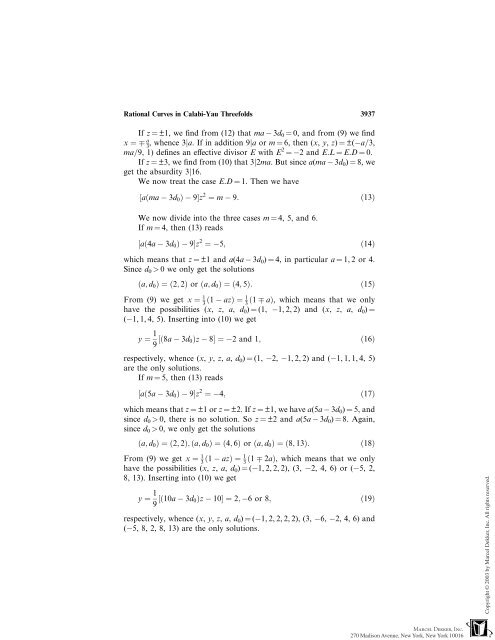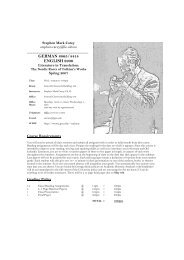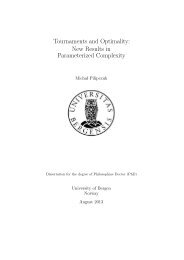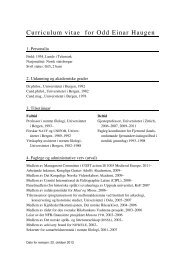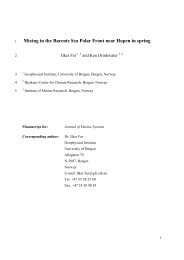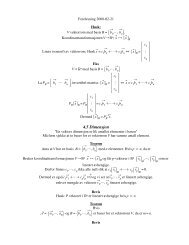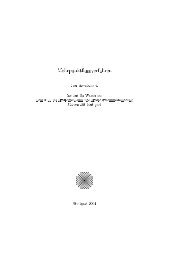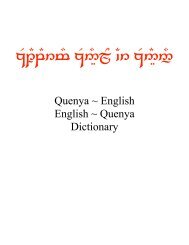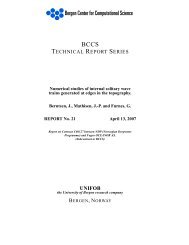Rational Curves in Calabi-Yau Threefolds
Rational Curves in Calabi-Yau Threefolds
Rational Curves in Calabi-Yau Threefolds
Create successful ePaper yourself
Turn your PDF publications into a flip-book with our unique Google optimized e-Paper software.
<strong>Rational</strong> <strong>Curves</strong> <strong>in</strong> <strong>Calabi</strong>-<strong>Yau</strong> <strong>Threefolds</strong> 3937<br />
If z ¼ ±1, we f<strong>in</strong>d from (12) that ma 3d0 ¼ 0, and from (9) we f<strong>in</strong>d<br />
x ¼ a<br />
3 , whence 3ja. If <strong>in</strong> addition 9ja or m ¼ 6, then (x, y, z) ¼ ±( a=3,<br />
ma=9, 1) def<strong>in</strong>es an effective divisor E with E 2 ¼ 2andE.L¼E.D¼0. If z ¼ ±3, we f<strong>in</strong>d from (10) that 3j2ma. But s<strong>in</strong>ce a(ma 3d0) ¼ 8, we<br />
get the absurdity 3j16.<br />
We now treat the case E.D ¼ 1. Then we have<br />
½aðma 3d0Þ 9Šz 2 ¼ m 9: ð13Þ<br />
We now divide <strong>in</strong>to the three cases m ¼ 4, 5, and 6.<br />
If m ¼ 4, then (13) reads<br />
½að4a 3d0Þ 9Šz 2 ¼ 5; ð14Þ<br />
which means that z ¼ ±1 and a(4a 3d0) ¼ 4, <strong>in</strong> particular a ¼ 1, 2 or 4.<br />
S<strong>in</strong>ce d 0 > 0 we only get the solutions<br />
ða; d0Þ ¼ð2; 2Þ or ða; d0Þ ¼ð4; 5Þ: ð15Þ<br />
From (9) we get x ¼ 1<br />
3 ð1 azÞ ¼1<br />
3 ð1 aÞ, which means that we only<br />
have the possibilities (x, z, a, d0) ¼ (1, 1, 2, 2) and (x, z, a, d0) ¼<br />
( 1, 1, 4, 5). Insert<strong>in</strong>g <strong>in</strong>to (10) we get<br />
y ¼ 1<br />
9 ½ð8a 3d0Þz 8Š ¼ 2 and 1; ð16Þ<br />
respectively, whence (x, y, z, a, d0) ¼ (1,<br />
are the only solutions.<br />
If m ¼ 5, then (13) reads<br />
2, 1, 2, 2) and ( 1, 1, 1, 4, 5)<br />
½að5a 3d0Þ 9Šz 2 ¼ 4; ð17Þ<br />
which means that z ¼ ±1 or z ¼ ±2. If z ¼ ±1, we have a(5a 3d0) ¼ 5, and<br />
s<strong>in</strong>ce d0 > 0, there is no solution. So z ¼ ±2 and a(5a 3d0) ¼ 8. Aga<strong>in</strong>,<br />
s<strong>in</strong>ce d 0 > 0, we only get the solutions<br />
ða; d0Þ ¼ð2; 2Þ; ða; d0Þ ¼ð4; 6Þ or ða; d0Þ ¼ð8; 13Þ: ð18Þ<br />
From (9) we get x ¼ 1<br />
3 ð1 azÞ ¼1<br />
3 ð1 2aÞ, which means that we only<br />
have the possibilities (x, z, a, d0) ¼ ( 1, 2, 2, 2), (3, 2, 4, 6) or ( 5, 2,<br />
8, 13). Insert<strong>in</strong>g <strong>in</strong>to (10) we get<br />
y ¼ 1<br />
9 ½ð10a 3d0Þz 10Š ¼2; 6or8; ð19Þ<br />
respectively, whence (x, y, z, a, d 0) ¼ ( 1, 2, 2, 2, 2), (3, 6, 2, 4, 6) and<br />
( 5, 8, 2, 8, 13) are the only solutions.


